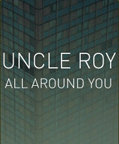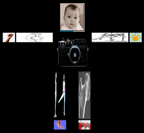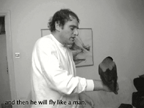:: Sunday, May 16, 2004 ::

ORIGINAL POST: Monday, May 10, 2004
BY: ana boa-ventura
"Uncle Roy All Around you" - Blast Theory, and other incursions of UK theater into the realm of SMS, PDAs and GPSs...
Blast Theory has just done another great "Uncle Roy all around you" performance, this time in Manchester, UK. The program read, "28 April - 2 May and 5 - 8 May (last entry for Street Players at 8pm)"...
Why that last note? Because “Uncle Roy All Around you” has some of Howard Rheingold's "smart mobs" but with a "twist", that being the game-like script (storyline) that makes the piece something between a MMORPG (Massive Multiplayer Online Role Playing Game), a novel and your worst nightmare.
UK is definitely the place bubbling with these creative theater groups that some call alternative theater, and that involve wireless, PDAs and people both on the street and online... and on the street/online.
Tim Etchell (read below) is another name to keep in mind. Titles like "Forced Entertainment" (the company he directs) or Surrender Control (one of the theatrical pieces) are self-explanatory.
Etchells:
"It's a very liberating moment when you admit that you aren't even tied to particular forms or strategies: that the next thing you do might be a publication, or a twenty-four hour performance or CD ROM or, indeed, a completely text-based performance, that you're tied to ideas, nothing more." (in interview to Caridad Svich for alternativetheater.com)
"Uncle Roy all around you"- http://www.uncleroyallaroundyou.co.uk/
Blast Theory- http://www.blasttheory.co.uk/
Forced Entertainment- http://www.forced.co.uk/

ORIGINAL POST: Sunday, May 09, 2004
BY: Garrett Lynch
The use of Google in net.art, (as already mentioned here before), has become a major artistic theme, only concreted by the arrival of O’Reilly's "Google Hacks 100 Industrial-Strength Tips and Tricks".
Some of you may know the Google Art creator / Google Groups Art and we have already reviewed the Googlehouse. Now there is My Google Body, a suitable inhabitant for the Googlehouse.
My Google Body is a portrait of its creator, a net.artist, as a Google image search query result. The body is split into its major parts - head, torso, arms, hands, legs, feet, and each of these words, the names for the body parts, are used as a keyword to search the Google image database. Google image search returns corresponding images that are then correctly assembled to create the body.
In a sense My Google Body is a return to early net.art concerns, representation / identity in virtual spaces by pseudonyms or avatars. It's continual animation and interchanging of body parts emphasizes the lack of correspondence between identity and physicality in virtual spaces.
Simplistic and classical (in terms of net.art history) these are My Google Bodies strong points that make it instantly recognizable and understandable.

ORIGINAL POST: Thursday, May 06, 2004
BY: Eduardo Navas
Doron Golan recently released two QuickTime movies online. The first is the 9th Allegro, a turbulence commission, and the second is The Tale of Crow, available on his the9th.com website.
The Ninth Allegro is a "documentary portrait" of Reb. Dan Harpe, a Hasidic Jew. In the beginning of the movie, he is seen inside his home performing rituals. These images are juxtaposed with outside shots of a kid and his mother, a camel, two dogs ready to have sex, and a man starting a fire in the middle of the desert. Throughout the movie the rabbi performs juggling tricks while a young apprentice tries to learn from him. The narrative presents an unexpected playfulness especially from the rabbi who appears serious in the beginning of the film. And while he's still serious when he starts juggling, this appears to be part of the discipline, necessary to perform juggling tricks perfectly. Hearing Beethoven’s “Symphony no.9, Allegro" as the soundtrack imposes a certain Western gaze onto the rabbi's activities, and although skepticism becomes obvious one cannot pinpoint what exactly should be questioned. On a formal level the coordination of the montage to the symphony is really great.
The Tale of Crow presents a man and his crow. Here again we see a film in slow motion. The sound has also been slowed down, offering distorted voices that are hard to understand. The man speaks in a foreign language and subtitles appear at the bottom of the screen. He appears with his crow at the beach and inside his apartment. While inside, he talks to a person outside of the frame, asking how to say "crow" in Georgian and in Russian; then the man says, "Cuervo," which means crow in Spanish. Shortly thereafter he walks out the room in slow motion. Here a piano soundtrack is heard throughout the movie; and again we have a narrative that is unexpectedly playful. The movie focuses on the crow as the signifier enabling us to consider identity (how to say crow in different languages?).
With this last statement in mind, it can be claimed that both pieces deal with issues of identity. While grasping the content may not be easy, the careful combination of music and visuals makes the movies aesthetically appealing, and this becomes the entry point to uncover the politics behind the short videos. These QuickTime movies seem to be at home online. Quite a treat.